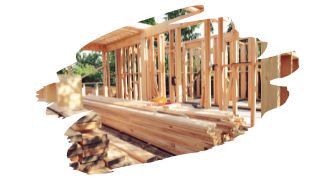When is whitewood not really Whitewood? Probably when you buy it from your local home improvement store.
And, no, that’s not the punchline to a joke. You see, whitewood is also the catch-all term given to lumber used mainly for framing, construction projects, and other outdoor applications.
So, in this article, you’ll learn the difference between Whitewood and the ‘whitewood’ sold at your home improvement store. You’ll also discover what makes Douglas Fir one of the best types of lumber for framing.
And keep reading to find out if genuine Whitewood is suitable for your next woodworking project.

This post may contain affiliate links to products that we receive a commission for (at no additional cost to you). Learn more here.
What Is Whitewood Exactly?
Well, Whitewood is another name for Tulipwood. Also known by the name, Yellow Poplar, this hardwood grows abundantly across North America.
It is great for making interior wood crafts such as cabinetry and furniture. And it’s also used for making musical instruments and wood whittling.
However, in home improvement stores, Whitewood is also a catch-all name given to various different types of framing lumber. And one of those home improvement store ‘whitewood’ lumbers happens to be Douglas Fir.
Related Post: Here’s Why Sealing Poplar For Outdoor Use Doesn’t Really Work
And What Kind Of Whitewood Is On Sale At My Home Improvement Store?
You’ll need to double check the sale ticket. But in general, Spruce, Pine and Douglas Fir are the three most popularly listed ‘whitewoods’ on offer.
All three of these softwoods are fairly lightweight, when you compare them against choice hardwood outdoor lumber, such as White Oak.
Is Whitewood (Tulipwood) Durable Enough For Framing?
No, not at all. It is not stable, meaning that changes in humidity — or a light sprinkling of rain – can cause it to shift. And that is a big problem for framing, because shifting will throw off the dimensions and measurements of the entire structure.
That doesn’t stop Tulipwood from sometimes being used for other exterior work such as siding. Yet, even then, Tulipwood isn’t chosen for siding because it is durable. It is simply used because it is cheap, costing much less than better choice exterior siding lumber, such as Western Red Cedar.
What About Douglas Fir? Is It A Durable Wood?
Douglas Fir is one of the most stable woods you can hope to use. After it’s been seasoned, (which takes 6-12 months after it’s been logged), it barely shifts around ever again.
And the reason for this is pretty simple. It doesn’t absorb water and moisture anywhere near as readily as most other types of wood. As a result, it doesn’t shrink and contract when that moisture dries out.

Related Post: What To Do When Solid Wood Cabinet Doors Start Warping (Solved!)
In addition to this, Douglas Fir has a very high strength-to-weight ratio for a softwood. And that’s why Douglas Fir is ideal for framing, outdoor construction, and other types of exterior building work.
Does Douglas Fir Need Treating?
Yes it does. This softwood isn’t impervious to decay. Douglas Fir may not warp and twist, but it will rot away in around 3 to 6 years, if it is left untreated.
This is why Douglas Fir — at least the kind meant for exterior projects — is pressure treated. Which means it’s been infused with wood preserving fungicides to help stave off the bacteria responsible for wood rot.
You can learn more about how to protect exterior Douglas Fir wood by checking out our post: What Is The Best Treatment For Douglas Fir Porch Decking?
So Which One’s Better? Douglas Fir Or Whitewood?
For outdoor projects, you should stick to Douglas Fir. Whitewood (Tulipwood) won’t last very long outside, even with a quality sealant.
But, Whitewood is lightweight, easy to machine, and carve. So, this wood is the better choice for interior woodworking projects, such as cabinets, coffee tables, and whittled wood crafts.
Related Post: Is Douglas Fir Any Good For Firewood?
To Wrap Up, Here Are The 3 Key Takeaways From This Post…
- 1). Whitewood is another name for Yellow Poplar. It is not a stable wood, meaning that it will warp and twist if used for framing work.
- 2). Whitewood is also the nickname that home improvement stores have given to a range of framing lumber. These ‘whitewoods’ often include softwoods such as Spruce, Pine, and Douglas Fir.
- 3) Douglas Fir is ideal for exterior projects, such as framing. However, it’ll need to undergo a wood preserving treatment, if it is to stave off rot and decay.
References:
Yellow-Poplar Lumber for Exterior Architectural Applications in New Construction and for Historical Restoration (purdue.edu)
